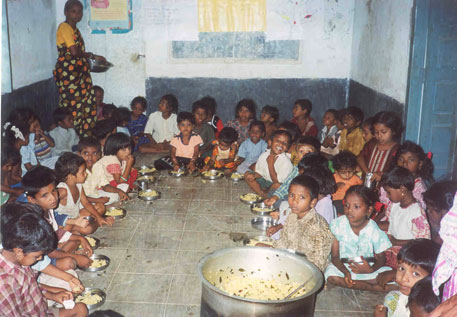The National Family Health Survey 2019-21 reveals that one in every three children below five years of age are stunted and underweight. Even the numbers on children’s urban nutritional status are far from being acceptable. The National Urban Health Mission Framework for Implementation Report, 2013 shows that over 46% of urban poor children are underweight and almost 60% miss total immunisation before completing one year, highlighting the issue of urban malnutrition.
Per the United Nations-Habitat’s World Cities Report 2022, the percentage of India’s population at mid-year residing in the urban area will increase from 31.16% in 2011 to 43.2% in 2035. Therefore, the increasing urban population coupled with growing socioeconomic and spatial disparities within cities will significantly impact child nutrition, specifically those from poor socioeconomic strata. According to the World Bank, ‘A 1 per cent loss in adult height due to childhood stunting is associated with a 1.4 per cent loss in economic productivity.’ Hence, urban children’s nutritional status is a critical indicator of the country’s development status.
Spatial Disparities within the Integrated Childhood Development Scheme
India’s flagship scheme for early childhood care and development (i.e.) the Integrated Childhood Development Scheme (ICDS) was initiated in 1975 to break the vicious cycle of child malnutrition, morbidity, reduced learning capacity, and mortality. Despite its universal nature, an urban-rural divide exists, with only 1.36 lakh Anganwadi centres (AWCs) located in urban areas against a total of 14 lakh AWCs sanctioned across states and union territories. A right to information query in 2020 revealed that for every 100 Anganwadi beneficiaries in the country, only seven are in urban areas.
Even within urban areas, further spatial disparities exist based on the nature of settlement. The access and utilisation of ICDS services in slum and non-slum areas show discrepancies, as highlighted by different studies. Furthermore, the nature of the slum (i.e.) recognised or notified, determines its access to public services. This becomes critical as children in such settlements are at high risk of malnutrition owing to poor or lack of access to potable drinking water, sanitation services, proper housing, and immunisation.
Challenges of Urban Anganwadis
The constraints of space, proper infrastructure, sanitation, and town planning, without adequate childcare provision, plague the functioning of urban ICDS. The absence of adequate and affordable land or government buildings to build ICDS centres is significantly hindering the construction of Anganwadis. Per the ICDS Monitoring Information System, about 24.3% of AWCs out of 13.63 lakh operational AWCs (rural and urban) run in rented buildings. Even in the case of renting, the low rent allocation under ICDS and poor status of rented building hinders efficient and effective delivery of services in the low income neighbourhoods.
Access to creche facilities in urban settings becomes crucial as mothers usually need to travel long distances for work and might not have the social networks to look after their children. This often results in the elder girl child taking on maternal tasks for the younger siblings, further aggravating the vulnerability of young children and adolescent girls. Furthermore, urban centres with high population density and larger migrant population pose unique challenges for Anganwadi workers in the delivery of services. Moreover, while rural Anganwadi workers have stronger community bonds with the beneficiaries, their urban counterparts find this challenging. Therefore, several spatial, infrastructural, and social challenges impact the urban AWCs.
Way Forward
A separate approach to urban ICDS services could be the way forward, given increasing urbanisation and demands for nutritional security and maternal health. AWC creches in urban settings can facilitate working women, especially those from the informal sector who do not have access to maternity rights, including paid maternity leaves and creche facilities. Furthermore, mapping AWC services closer to slums can ensure ease of access and better outreach. Portable structures like those adopted by Mohalla Clinics in New Delhi can be used to overcome the lack of space in dense urban settings. Simultaneously, AWCs can be relocated to schools. Increased involvement of local communities within ICDS beyond its current focus on mother and child is crucial for the ‘continuum of care’ through awareness programmes that can enhance ICDS services to help reduce maternal and child mortality. Additionally, it would be beneficial to develop city-specific education programmes for educating mothers about changing complementary feeding practices. Monitoring implementation by active engagement with community-based organisations, non-governmental organisations, and urban local bodies can also strengthen the services. Lastly, corporate social responsibility funds from the private sector can be used to strengthen the urban nutrition framework.
It is a matter of equity and a right to improve the health and nutrition of urban poor children. Decision-makers can use pilot interventions as a long-term policy tool to investigate and identify localised models while ensuring the accountability of different stakeholders, which can improve the urban ICDS programmes. The aim should be to enhance the availability, accessibility, and quality of child development services, especially in impoverished neighbourhoods. ICDS is crucial for a child’s nutritional status, enabling better health and nutrition outcomes, and supporting SDG Goal 2 on ‘ending all forms of malnutrition’.
Read more: The Need for Comprehensive Sexuality Education in Indian Schools
Post Disclaimer
The opinions expressed in this essay are those of the authors. They do not purport to reflect the opinions or views of CCS.






